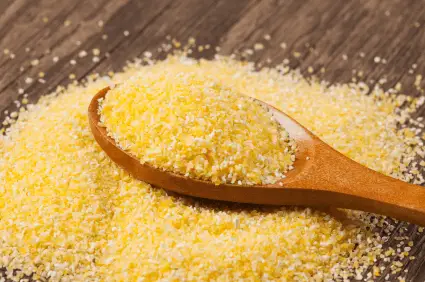Corn is a source of many food products, including grits and cornmeal. Both come from maize, but they are just as different as they are similar! This article highlights how they are separate corn products.
Summary Table
| Grits | Cornmeal |
| Is boiled, coarsely ground corn | Is ground dried corn |
| Typically served as a breakfast food | Used in cornbread, griddle cakes, fried foods, and pizza crusts |
Definitions

Grits are a Native American food made from boiled, ground corn. They are typically served mixed with other flavorings as a breakfast meal. Despite their origin, grits became popular among folks in the southern states and are now available all throughout the US. Restaurants in the South serve grits with shrimp as an evening entree. Although “hasty pudding” is made the same way (boiled ground maize), it is not to be confused with the coarsely ground grits. Grits are also very similar to other thick corn-based porridges from various countries all over the globe. The word “grits” is derived from “grytt,” which is an old English term for coarse meal.
A third of all grits sold in the US are bought in the South, from an area that spans from Texas to Virginia and is called the “grits belt.” In 2002, grits were declared the official prepared food of the state of Georgia.
Grits are typically eaten accompanied by a wide range of food such as bacon and eggs, country ham, salmon croquettes, fried catfish, and many more dishes. Solidified grits can be sliced and fried in vegetable oil, bacon grease, or butter. They can also be breaded using beaten eggs and bread crumbs prior to being fried.
Grits come in yellow or white, depending on the color of the corn. “Quick grits” sold in supermarkets are the most common version. This variety has its germ and hull removed, while whole kernel grits are usually called stone ground grits.
Grits are made from dried, ground corn, though they’re sometimes made with hominy. Hominy is corn that’s treated with lime to remove its hull. Some people referred to the corn used for hominy as “dent.” That’s because each kernel of corn has an indentation after it’s been dried.
Hominy also contains a soft starch that makes grits develop a smooth, creamy sauce. Some people like to add other ingredients to their grits, such as sausage, bacon, crab, shrimp, and more.
When you head to the grocery store to buy grits, you may be confused by the different varieties available. For instance, you can find instant or stone-ground grits. Instant grits are more refined than the stone-ground version, so they can cook faster.

Cornmeal is a staple food that comes from ground dried corn. It is ground to various consistencies, ranging from fine, to coarse. Finely ground cornmeal is considered “corn flour” in the US. Cornmeal from maize soaked in limewater (i.e. nixalization) is called “masa,” a basic ingredient for making tortillas and tamales. When cornmeal is boiled, it is referred to as “polenta.”
There are several types of cornmeal. Blue cornmeal is made of fine or medium ground dried corn kernels. It has a violet or light blue color and a sweet taste.There is steel-ground yellow cornmeal which is common in most US states. Stone-ground cornmeal is more flavorful and nutritious. It is more perishable but will have a longer shelf life if kept refrigerated. White cornmeal is from white corn and is well-known in some African territories. It is a popular ingredient for cornbread in the Southern states.
Cornmeal can be used to dust baking surfaces for bread and pizza, keep foods from sticking, and give a dish more texture. It is often used as an ingredient in batters for deep-frying, improving flavor, and providing more texture.
Another staple that’s common across the US is cornbread, which uses cornmeal as its main ingredient. Cornbread is a quick bread that originated from the Native Americans. It’s a favorite in many Southern states in the US; however, you can find this yummy bread all across the country. Cornbread is eaten with a wide range of meals.
Can You Substitute Cornmeal for Grits in a Recipe?
You can use cornmeal, but the finished dish will not have the same flavor or texture as it does when using grits.
Are Corn Grits the Same as Corn Grain?
Yes, corn grits are ground corn; however, they don’t have the outer corn kernel (also referred to as the bran) or the germ.
Grits vs Cornmeal
So what is the difference between grits and cornmeal? Grits are made by grounding corn into a coarse meal which is boiled thereafter. Cornmeal, on the other hand, is ground dried corn. While grits are a coarse meal, cornmeal comes in finely ground, (i.e. corn flour) medium, and coarse ground varieties. When boiled, ground corn becomes grit, but boiled cornmeal is known as polenta.






